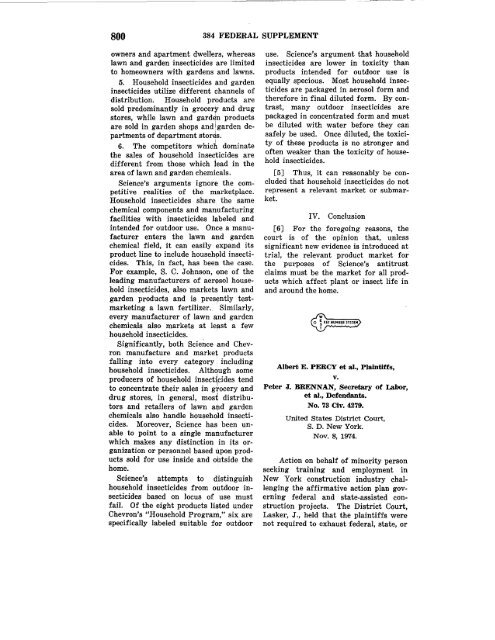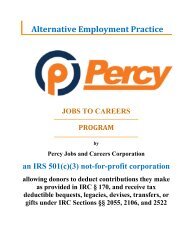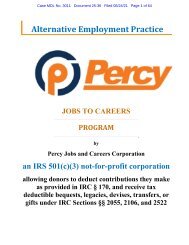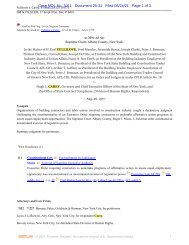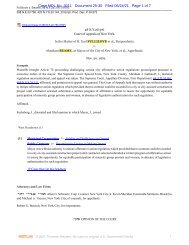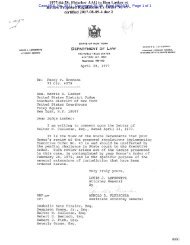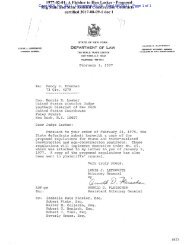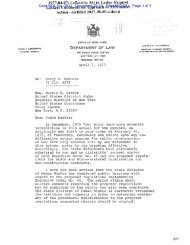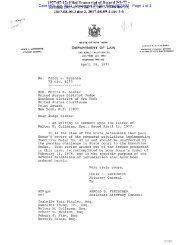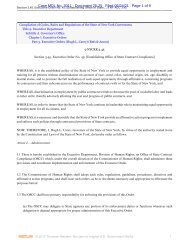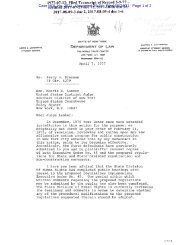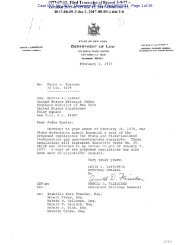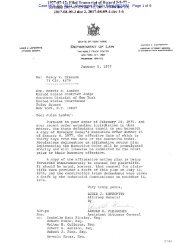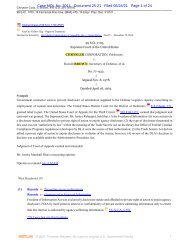384_F.Supp 800, 807
Percy v. Brennan
Percy v. Brennan
You also want an ePaper? Increase the reach of your titles
YUMPU automatically turns print PDFs into web optimized ePapers that Google loves.
<strong>800</strong> <strong>384</strong> FEDERAL SUPPLEMENT<br />
owners and apartment dwellers, whereas<br />
lawn and garden insecticides are limited<br />
to homeowners with gardens and lawns.<br />
5. Household insecticides and garden<br />
insecticides utilize different channels of<br />
distribution. Household products are<br />
sold predominantly in grocery and drug<br />
stores, while lawn and gardJn products<br />
are sold in garden shops and i garden departments<br />
of department stor~s.<br />
6. The competitors which dominate<br />
the sales of household insecticides are<br />
different from those which iead in the<br />
area of lawn and garden chemicals.<br />
Science's arguments ignore the competitive<br />
realities of the marketplace.<br />
Household insecticides share the same<br />
chemical components and manufacturing<br />
facilities with insecticides labeled and<br />
intended for outdoor use. Once a manufacturer<br />
enters the lawn and garden<br />
chemical field, it can easily expand its<br />
product line to include househpld insecticides.<br />
This, in fact, has been the case.<br />
For example, S. C. Johnson, one of the<br />
leading manufacturers of aerosol household<br />
insecticides, also markets lawn and<br />
garden products and is presently testmarketing<br />
a lawn fertilizer. · Similarly,<br />
every manufacturer of lawn and garden<br />
chemicals also markets at least a few<br />
household insecticides. ·<br />
Significantly, both Science and Chevron<br />
manufacture and market products<br />
falling into every category including<br />
household insecticides. Although some<br />
producers of household insecti'cides tend<br />
I<br />
to concentrate their sales in grocery and<br />
drug stores, in general, most distributors<br />
and retailers of lawn and garden<br />
chemicals also handle household insecticides.<br />
Moreover, Science has been unable<br />
to point to a single manufacturer<br />
which makes any distinction in its organization<br />
or personnel based upon products<br />
sold for use inside and outside the<br />
home.<br />
Science's attempts to distinguish<br />
household insecticides from outdoor insecticides<br />
based on locus of use must<br />
fail. Of the eight products listed under<br />
Chevron's "Household Program," six are<br />
specifically labeled suitable for outdoor<br />
use. Science's argument that household<br />
insecticides are lower in toxicity than<br />
products intended for outdoor use is<br />
equally specious. Most household insecticides<br />
are packaged in aerosol form and<br />
therefore in final diluted form. By contrast,<br />
many outdoor insecticides are<br />
packaged in concentrated form and must<br />
be diluted with water before they can<br />
safely be used. Once diluted, the toxicity<br />
of these products is no stronger and<br />
often weaker than the toxicity of household<br />
insecticides.<br />
[5] Thus, it can reasonably be concluded<br />
that household insecticides do not<br />
represent a relevant market or submarket.<br />
IV.<br />
Conclusion<br />
[6] For the foregoing reasons, the<br />
court is of the opinion that, unless<br />
significant new evidence is introduced at<br />
trial, the relevant product market for<br />
the purposes of Science's antitrust<br />
claims must be the market for all products<br />
which affect plant or insect life in<br />
and around the home.<br />
w<br />
0 i K',-EY-HU-H-BE-R S-YS-TEH""'<br />
T<br />
Albert E. PERCY et al., Plaintiffs,<br />
v.<br />
Peter J. BRENNAN, Secretary of Labor,<br />
et al., Defendants.<br />
No. 78 Civ. 4279.<br />
United States. District Court,<br />
S. D. New York.<br />
Nov. 8, 1974.<br />
Action on behalf of minority person<br />
seeking training and employment in<br />
New York construction industry challenging<br />
the affirmative action plan governing<br />
federal and state-assisted construction<br />
projects. The District Court,<br />
Lasker, J., held that the plaintiffs were<br />
not required to exhaust federal, state, or
PERCY v. BRENNAN 801<br />
Cite as <strong>384</strong> F.<strong>Supp</strong>. <strong>800</strong> (1074)<br />
city administrative remedies; that the 3. United States ~73(9)<br />
individual and organizational plaintiffs Director of Office of Federal Conhad<br />
standing to bring the action; that tract Compliance has jurisdiction over<br />
the State Department of Labor was im- allegations of discrimination of prime<br />
mune from suit under doctrine of sover- contractor and subcontractor, but does<br />
eign immunity and because its agencies not have jurisdiction to inquire into unwere<br />
not "persons" within the meaning constitutionality of contract's equal emof<br />
the Civil Rights Act; that the action ployment opportunity clause. Executive<br />
could be maintained as a class action; Order No. 11246, 42 U .S.C.A. § 2000e<br />
that an evidentiary hearing was necessary<br />
for determination of the affirmative<br />
action plan's validity; and that letters<br />
issued by the Federal and State Departments<br />
of Labor concerning the affirmative<br />
action plan were invalid for<br />
failure to be published in accordance with<br />
federal and state law.<br />
Plaintiffs' motion for determination<br />
of class, for partial summary judgment,<br />
and for preliminary relief, granted in<br />
part.<br />
Defendants' motions to dismiss<br />
granted in part and denied in part.<br />
1. Declaratory Judgment ~203<br />
Members of minority group seeking<br />
declaration of invalidity of affirmative<br />
action plan governing state and federal<br />
construction projects did not have to ex.;.<br />
haust administrative remedies by suh<br />
0<br />
mitting complaint to Equal Employment<br />
Opportunity Commission and Director of<br />
Office of Federal Contract Compliance;<br />
since those agencies had no jurisdiction<br />
to hear complaints regarding unconstitu.i.<br />
tional affirmative action plans. CiviJ<br />
Rights Act of 1964, §§ 701 et seq., 703<br />
to 705, 42 U.S.C.A. §§ 2000e et seq~~<br />
2000e-2 to 2000e-4; Executive Order<br />
No. 11246, 42 U.S.C.A. § 2000e note. "<br />
2. Civil Rights ~9.10 ...<br />
"Unlawful employment practice" in<br />
purview of Civil Rights Act of 1964 doet\<br />
not include promulgation of unconstitutional<br />
affirmative action plan. Ci~il<br />
Rights Act of 1964, §§ 701 et seq., '(03<br />
to 705, 42 U.S.C.A. §§ 2oooe et seq.,<br />
2000e-2 to 2000e-4; Executive Ord~r<br />
No. 11246, 42 U.S.C.A. § 2oooe note.<br />
See publication Words and Phrases<br />
for other judicial constructions and<br />
definitions.<br />
<strong>384</strong> F. <strong>Supp</strong>.-51<br />
note.<br />
4. Civil Rights ~9.10<br />
Equal employment opportunities<br />
provisions of the Civil Rights Act of<br />
1964 neither prohibit discriminatory<br />
acts by government officials, except<br />
where government is employer, nor proscribe<br />
activities of government officials<br />
or private entities which operate to foster<br />
discrimination by employers or unions.<br />
Executive Order No. 11246, 42 U.<br />
S.C.A. § 2000e note.<br />
5. Civil Rights ~13.1<br />
Resort to employment discrimination<br />
remedies of Civil Rights Act of<br />
1964 was not prerequisite to antidiscrimination<br />
suit under Civil Rights Act of<br />
1870. 42 U.S.C.A. § 1981.<br />
6. Civil Rights ~62<br />
Commissions established by New<br />
York State Human Rights Law and New<br />
York City were authorized only to hear<br />
complaints involving discriminatory employment<br />
practices by employers, employment<br />
agencies, labor organizations,<br />
and apprenticeship committees, and had<br />
no jurisdiction to consider possible unconstitutionality<br />
of affirmative action<br />
plan governing federal and state-assisted<br />
construction projects. Executive Law<br />
N.Y. §§ 296, 297; Administrative Code<br />
N.Y. § Bl-7.0(a-c).<br />
7. Administrative La.wand Procedure<br />
~229<br />
Plaintiffs cannot be required to exhaust<br />
state procedures when there is no<br />
administrative remedy by which plaintiffs<br />
could have any assurance of getting<br />
relief they want.<br />
8; Constitutional La.w ~42.2(2)<br />
Black and Hispanic construction<br />
workers who allegedly had been and con-
802 <strong>384</strong> FEDERAL SUPPLEMENT<br />
tinued to be denied employment in construction<br />
industry had standing to bring<br />
action challenging constitutionality of<br />
affirmative action plan governing federal<br />
and state-assisted construction projects.<br />
Executive Order No. 11246, 42 U.<br />
S.C.A. § 2000e note.<br />
9. Civil Rights e::>9.10<br />
· Constitutional Law e::>215, 253(1)<br />
Injuries resulting from racial discrimination<br />
fall squarely within protection<br />
of Fifth and Fourteenth Amendments<br />
to the Constitution, Civil Rights<br />
Act of 1870, and Executive Order concerning<br />
requirement that federal contractors<br />
hire on nondiscriminatory basis.<br />
42 U.S.C.A. § 1981; U.S;C.A.Const.<br />
Amends. 5, 14; Executive Order No.<br />
11246, 42 U.S.C.A. § 2000e note.<br />
10. Constitutional Law e::>42.2(2)<br />
Organization of black and Hispanic<br />
construction workers dedicated to obtaining<br />
employment for such workers in<br />
construction industry and national organization<br />
seeking to protect civil rights<br />
of black persons had standing to bring<br />
action challenging constitutionality of<br />
affirmative action plan governing federal<br />
and state construction projects. Executive<br />
Order No. 11246, 42 U.S.C.A. §<br />
2000e note.<br />
11. Federal Civil Procedure e::>161<br />
Class of persons and associations<br />
representing members of that class could<br />
both proceed as proper plaintiffs.<br />
12. Civil Rights e::>13.7<br />
Claim could not be maintained<br />
against New York Department of Labor<br />
under Civil Rights Act of 1870 since<br />
state and its agencies are not "persons"<br />
within meaning of Civil Rights Act. 42<br />
U.S.C.A. § 1981.<br />
See publication Words and Phrases<br />
for other judicial constructions and<br />
definitions.<br />
13. Stat.es ~191(1.20)<br />
Doctrine of sovereign ~mmunity<br />
barred action against New York Department<br />
of Labor under Constitution and<br />
Executive Order concerning requirement<br />
of nondiscriminatory employment practices<br />
by federal contractors. Executive<br />
Order No. 11246, 42 U .S.C.A. § 2000e<br />
note.<br />
14. States e::>191(L20)<br />
New York's statutory waiver of im:.<br />
munity from suit did not encompass action<br />
by minority members against New<br />
York Department of Labor challenging<br />
affirmative action plan governing federal<br />
and state-assisted construction projects.<br />
Executive Order No. 11246, 42 U.<br />
S.C.A. § 2000e note.<br />
15. Civil Rights e::>42<br />
Complaint alleging that Governor of<br />
New York was charged with duty of<br />
forcing equal employment opportunity<br />
requirements applicable in State, and Industrial<br />
Commissioner was responsible<br />
for enforcing equal employment opportunity<br />
requirements on public construction<br />
sites stated cause of action against Governor<br />
and Commissioner for alleged failure<br />
to properly enforce such requirements.<br />
16. Federal Civil Procedure e::>184<br />
Action challenging constitutionality<br />
of affirmative action plan governing<br />
federal and state-assisted construction<br />
projects could be maintained as class action<br />
with class defined as all black and<br />
Spanish surnamed persons who were capable<br />
of and wished to perform construction<br />
work in area governed by affirmative<br />
action plan. Fed.Rules Civ.<br />
Proc. rule 23(a) (2), 28 U.S.C.A.<br />
17. Federal Civil Procedure ~161<br />
There is no geographical or numerical<br />
limit as such on scope of class for<br />
maintenance of class action. Fed.Rules<br />
Civ.Proc. rule 23, 28 U.S.C.A.<br />
18. Federal Civil Procedure e::>161<br />
There is no requirement to establish<br />
need for maint!lining class action if relief<br />
with respect to class is otherwise<br />
appropriate. Fed.Rules Civ.Proc. rule<br />
23(b) (2), 28 U.S.C.A.<br />
19. Civil Rights e::>9.10<br />
If requirements of affirmative action<br />
plan were so minimal that they resulted,<br />
albeit unintentionally, in governmental<br />
acquiescence in racially discrimi-
PERCY v. BRENNAN<br />
Cite as <strong>384</strong> F.<strong>Supp</strong>. <strong>800</strong> (1974)<br />
803<br />
natory practices, then greater efforts Robert G. Benisch, Berman, Paley,<br />
were mandated by Constitution and fed- Goldstein & Berman, Robert J. Fink,<br />
eral law, and until more rigorous plan French, Fink, Markle & McCallion, New<br />
was imposed, rights of minorities dis- York City, for the New York Plan for<br />
criminated against were being violated. Training, Inc. etc.<br />
20. Civil Rights €:=>46<br />
Where evidentiary hearing was· necessary<br />
to establish facts which were<br />
critical to determination of affirmative<br />
action plan's constitutional validity, preliminary<br />
injunction of operation of plan<br />
was denied. Executive Order No. 11246,<br />
42 U.S.C.A. § 2000e note.<br />
21. Administrative Law and Procedure<br />
€:=>408<br />
Civil Rights €:=>31<br />
Letter from Department of Labor,<br />
establishing guidelines for imposition of<br />
affirmative action plans on local construction<br />
industry was invalid because it<br />
was not published in accordance with requirements<br />
of Administrative Procedure<br />
Act, and because it was unauthorized attempt<br />
to preempt local equal employment<br />
opportunity efforts. Executive Order<br />
No. 11246, 42 U.S.C.A. § 2000e note; 5<br />
U.S.C.A. §§ 552, 553.<br />
22. Administrative Law and Procedure<br />
€:=>408<br />
Civil Rights €:=>61<br />
Letter from New York State Industrial<br />
Commissioner establishing procedure<br />
for future approval of affirmative<br />
action plans was invalid for failure<br />
to meet constitutional and statutory publication<br />
requirements. Executive Law<br />
N.Y. § 102; Const.N.Y. art. 4, § 8.<br />
Dennis R. Yeager, Diana Greene, Isabelle<br />
Katz Pinzler, Nathaniel R. Jones,<br />
William D. Wells, New York City, for<br />
plaintiffs.<br />
Paul J. Curran, U. S. Atty., S. D .. N.<br />
Y., Steven Glassman, Asst. U. S. Atty.,<br />
Louis J. Lefkowitz, Atty. Gen., Lloyd G.<br />
Milliken, Asst. Atty. Gen., New York<br />
City, for defendants.<br />
Walter H. Colleran, Doran, Colleran,<br />
O'Hara, Pollio & Dunne, P. C., New<br />
York City, for Building and Construction<br />
Trades Council of New York, etc.<br />
LASKER, District Judge.<br />
This case, brought on behalf of minority<br />
persons seeking training and employment<br />
in the New York construction industry,<br />
challenges the affirmative action<br />
plan, ("the New York Plan") which currently<br />
governs Federal and State assisted<br />
construction projects in New York<br />
City. The primary claim raised by the<br />
complaint is that the New York Plan<br />
fails to guarantee equal protection and<br />
the right to equal employment opportunities<br />
as required by the United States<br />
Constitution, 42 U.S.C. § 1981 and Executive<br />
Order No. 11246. At issue also is<br />
the validity of federal and state attempts<br />
to pre-empt local government efforts<br />
to impose affirmative action requirements<br />
which are more rigorous<br />
than those contained in the New York<br />
Plan, although our decision in City v.<br />
Diamond, 379 F.<strong>Supp</strong>. 503 (S.D.N.Y.<br />
1974) has at least partially disposed of<br />
this aspect of the case.<br />
The plaintiffs are Albert Percy, Manuel<br />
R. Mejia, and John Mercado, who<br />
move to represent a class of fellow black<br />
and Spanish-surnamed individuals seeking<br />
employment in the construction industry,<br />
and two organizations, Fight<br />
Back and National Association for the<br />
Advancement of Colored People<br />
(NAACP). Defendants are the Secretary<br />
of Labor, the United States Department<br />
of Labor, the Assistant Secretary<br />
of Labor for Employment Standards, the<br />
Director of the Office of Federal Contract<br />
Compliance and the Office of Federal<br />
Contract Compliance (federal defendants)<br />
; the Governor of the State of<br />
New York, the Industrial Commissioner<br />
of the State of New York and the New<br />
York State Department of Labor (state<br />
defendants); and the Building and Construction<br />
Trades Council of Greater New<br />
York, the New York Building and Construction<br />
Industry Board of Urban Af-
804 <strong>384</strong> FEDERAL SUPPLEMENT<br />
fairs Fund (Fund) and the New York<br />
Plan for Training, Inc. (private defendants).<br />
Plaintiffs seek declaratory relief and<br />
an injunction ordering the federal and<br />
state officials to abandon the New York<br />
Plan, to withdraw memoranda which<br />
prohibit local governments from imposing<br />
any equal employment opportunity<br />
requirements which have not been approved<br />
by federal and state Departments<br />
of Labor, and to promulgate affirmative<br />
action goals for public construction sites<br />
which comport with the requirements of<br />
the United States Constitution, 42 U.S.<br />
C. § 1981 and Executive Order No.<br />
11246. Plaintiffs move for · a preliminary<br />
injunction, partial summary judgment<br />
and a class action determination.1<br />
All defendants move to dismiss. We<br />
deal initially with those facts and legal<br />
challenges going to the validity of the<br />
New York Plan, and then consider the<br />
remaining issues.<br />
I. THE NEW YORK PLAN<br />
A. FACTS<br />
The New York Plan was established<br />
in 1970 to comply with Executive Order<br />
No. 11246 (Order) which imposed broad<br />
equal employment obligations on federal<br />
and federally-assisted contractors. Part<br />
I of the order requires that federallyfunded<br />
contracts include the provision<br />
that:<br />
"The contractor will not discriminate<br />
against any employee or applicant<br />
for employment because of race,<br />
color, religion, sex, or national origin.<br />
The contractor will take affirmative<br />
action to ensure that applicants are employed<br />
and that employees are treated<br />
during employment, without. regard to<br />
their race, color, religion, sex or national<br />
origin. Such action shall include,<br />
but not be limited to the following:<br />
employment, upgrading, demotion,<br />
or transfer; recruitment or recruitment<br />
advertising ; layoff or ter-<br />
I. Plaintiffs' motion to consolidate this case<br />
with a related one, City v. Diamond, 379 F.<br />
<strong>Supp</strong>. 503 (S.D.N.Y., 1974) is moot in light<br />
minatiori; rates of pay or other forms<br />
of compensation; and selection for<br />
training, including apprenticeship."<br />
Order at § 202.<br />
The contractor must also undertake to<br />
"comply with all provisions of Executive<br />
Order No. 11246<br />
and of the<br />
rules, regulations, and relevant orders of<br />
the Secretary of Labor." Order at §<br />
202.<br />
The Secretary of Labor is responsible<br />
for enforcement of the compliance provisions<br />
of the order, contained in Parts II<br />
and III. Order at § 201. The Director<br />
of the Office of Federal Contract Compliance<br />
is authorized to implement the<br />
equal employment policies of the Secretary<br />
of Labor. (Order No. 15-68 of the<br />
Secretary of Labor, 33 Fed.Reg. 2600<br />
(Sept. 4, 1968).) Compliance with the<br />
order is obtained through adherence either<br />
to an "imposed plan" or a "hometown<br />
plan".<br />
An imposed plan, as the name indicates,<br />
is a plan which is imposed by the<br />
Secretary of Labor, establishing yearly<br />
minority employment goals on a tradeby-trade<br />
basis, with increasing minority<br />
participation each year. Responsibility<br />
for compliance rests with individual contractors.<br />
A hometown plan typically<br />
combines the efforts of local contractors<br />
and contractors' associations, building<br />
trades unions and minority organizations,<br />
and results in the formulation of a<br />
plan for voluntary compliance with the<br />
order. Under a hometown plan, minority<br />
participation obligations fall on the<br />
trade as a whole rather than on any individual<br />
contractor, and can be satisfied<br />
by minority employment or training on<br />
any work performed by the trade,<br />
whether federally-funded or private.<br />
The hometown plan approach holds the<br />
unions rather than the individual contractors<br />
responsible for complying with<br />
the affirmative action requirements.<br />
An administrative committee assigns<br />
"fair share goals" to individual contractors.<br />
A hometown plan must be submitof<br />
our having rendered a decision in that<br />
case.
PERCY v. BRENNAN<br />
Cite as <strong>384</strong> F.<strong>Supp</strong>, <strong>800</strong> (11¥74)<br />
805<br />
ted to the Office of Federal Contract specified that "The number of Trainees<br />
Compliance for approval and, if ap- the program shall provide for within the<br />
proved, is incorporated by reference into first year shall be set at <strong>800</strong> maximum."<br />
Part I of the Federal Equal Employment (Plan, Article IV, of § 2) Goals were<br />
Opportunity Bid Conditions (Federal established on a craft-to-craft basis, and<br />
Bid Conditions) used for all non-exempt qualified graduates of the program were<br />
federally-assisted construction projects to be recommended to the appropriate<br />
in the geographical area of the home- union "for consideration for membertown<br />
plan. ship." (Plan, Article II, § 2).<br />
For any trades not participating in<br />
the hometown plan, mandatory affirmative<br />
action requirements are set forth in<br />
Part II of the Federal Bid Conditions.<br />
Responsibility for compliance with these<br />
requirements is imposed directly on the<br />
individual contractor, rather than on the<br />
non-participating trade as a whole.<br />
Part IV of the Federal Bid Conditions<br />
provides that the failure of a contractor<br />
to make good faith efforts to meet his<br />
fair share obligations under a hometown<br />
plan can result in his being placed under<br />
Part II of the conditions, as well as possible<br />
imposition of the sanctions authorized<br />
by Section 209 of Executive Order<br />
No. 11246.<br />
The federally approved hometown plan<br />
in New York City, which is challenged<br />
here, is the New York Plan. It was<br />
submitted to the federal government for<br />
approval in 1970 by the Board of Urban<br />
Affairs, a body comprised of labor and<br />
management groups. The New York<br />
Plan became effective after approval respectively<br />
by the Mayor (Executive<br />
Order # 31), the Governor (Executive<br />
Order # 43) and, in August 1971, by the<br />
Office of Federal Contract Compliance.<br />
The Plan has been extended from time to<br />
time and is presently scheduled to expire<br />
at the end of December, 1974.<br />
The New York Plan (Amended Complaint,<br />
Exhibit A) (Plan) originally<br />
The Plan expired by its terms on July<br />
1, 1972, but, as indicated already, it has<br />
been extended from time to time. The<br />
extended plan differs from the original<br />
in providing for the training of 1,000<br />
rather than <strong>800</strong> minority workers.2<br />
B. MOTIONS TO DISMISS<br />
The grounds of the motions to dismiss<br />
include: (1) the federal defendants'<br />
claim that the plaintiffs have failed to<br />
exhaust federal administrative remedies;<br />
(2) the state and private defendants'<br />
claim that the plaintiffs have<br />
failed to exhaust federal, state and city<br />
administrative remedies; (3) the federal<br />
defendants' assertion that the individual<br />
plaintiffs lack standing; ( 4) the<br />
private defendants' claim that Fight<br />
Back and NAACP lack standing; (5)<br />
the state defendants' claim that the<br />
State Department of Labor is immune<br />
from suit; and ( 6) their assertion that<br />
the complaint fails to state a cause of<br />
action against the Governor and the Industrial<br />
Commissioner.3<br />
1. Exhaustion of Federal Administrative<br />
Remedies Under 28 U.S.C.<br />
§ 1331.<br />
[1] The federal defendants move to<br />
dismiss for failure by the plaintiffs to<br />
submit their complaint to the Equal Employment<br />
Opportunity Commission and<br />
the Director of the Office of Federal<br />
2. New York City originally was a participant<br />
in the New York Plan, but withdrew from<br />
the Plan in January, 1973. Thereafter, the<br />
City promulgated its own rules and regula·<br />
tions, effective July 20, 1973. These rules<br />
and regulations, together with the Mayor's<br />
Executive Orders No. 20 of July 15, 1970,<br />
and No. 71 of April 2, 1968 constitute the<br />
"Mayor's Plan," which imposes an obligation<br />
on public contractors, individually rather than<br />
by trade, to make among other requirements<br />
a good faith effort to employ one minority<br />
trainee per four journeymen.<br />
3. While the motions to dismiss, of course,<br />
address themselves to the entire complaint,<br />
those aspects which we here decide relate to<br />
the New York Plan. As already noted, we<br />
deal later in the text with those arguments<br />
and motions which concern the Brennen<br />
Memorandum and the State letter.
806 <strong>384</strong> FEDERAL SUPPLEMENT<br />
Contract Compliance. Their motion is<br />
denied because these administrative procedures<br />
cannot afford plaintiffs the relief<br />
they request.<br />
[2] Although Congress established<br />
an Equal Employment Opportunity Commission<br />
to hear cases involving employment<br />
discrimination, the jurisdiction of<br />
the Commission is limited to complaints<br />
which allege "that an employEk, employment<br />
agency, labor organizati9n or joint<br />
labor-management committee ~ontrolling<br />
apprenticeship or other train:ing or re- .<br />
training, including on-the-jol) training<br />
programs, has engaged in an unlawful<br />
employment practice." 42 U.S.C. §<br />
2000e-4. Sections 2000e-2 and 2000e-3,<br />
which define "unlawful employment practices,"<br />
do not include the promulgation of<br />
an unconstitutional affirmative action<br />
plan.4<br />
i<br />
The cases cited by the federal defendants<br />
do not support their claim, for<br />
while the court in Hadnott v. J.,aird, 149<br />
U.S.App.D.C. 358, 463 F.2d: 304, 305<br />
( 1972) . dismissed the complai~t for the<br />
plaintiffs' failure to appear fir st before<br />
the Equal Employment Opportunity<br />
Commission, the claim there essentially<br />
alleged that individual employers were<br />
failing to fulfill their contractual commitment<br />
to non-discrimination.. Similarly,<br />
in Freeman v. Shultz, 153 U.S.App.<br />
D.C. 16, 468 F.2d 120 (1972); plaintiff<br />
sought to enjoin the award of contracts<br />
to employers who had discriniinated on<br />
the basis of race. Yet here,' as plaintiffs<br />
note, the complaint is not one under<br />
Title VII ; plaintiffs here are not<br />
asking that the sanctions of Executive<br />
Order No. 11246 be imposed u,pon third<br />
parties who fail to fulfill contract obligations<br />
but that the federal defendants<br />
themselves be enjoined. ·· (Plaintiffs'<br />
Memorandum at p. 25). And in a case<br />
similar to the one here, where contractors<br />
challenged the constitutionality of<br />
an "imposed plan" (the Philadelphia<br />
Plan) the district court stated, "It is apparent<br />
that the legal issue that the<br />
plaintiffs here presented is fit for judicial<br />
resolution." No indication was<br />
made of a previous determination by the<br />
Equal Employment Opportunity Commission,<br />
which suggests that no such appearance<br />
was found to be required.<br />
Contractors Ass'n of Eastern Pa. v.<br />
Sec'y of Labor, 311 F.<strong>Supp</strong>. 1002, 1007<br />
(E.D.Pa.1970), aff'd, 442 F.2d 159<br />
(3d Cir.), cert. denied, 404 U.S. ·854, 92<br />
S.Ct. 98, 30 L.Ed.2d 95 (1971).<br />
[3] Neither can plaintiffs seek relief<br />
from the Director of the Office of Federal<br />
Contract Compliance.5 Regulations<br />
promulgated by the Office give the<br />
Director power to ensure compliance<br />
with Executive Order No. 11246, · but<br />
however broad the scope of those regulations,<br />
a complainant may only challenge<br />
the alleged discrimination of a "prime<br />
contractor or subcontractor", ( 41 C.F .R.<br />
§ 1.23(a)), not the unconstitutionality<br />
of the contract's equal employment opportunity<br />
clause itself.<br />
2. Exhaustion of Federal, Administrative<br />
Remedies Under 4~ · U.S.C.<br />
§ 1981.<br />
[ 4, 5] The state defendants also assert<br />
that plaintiffs have adequate remedies<br />
under federal statutes.<br />
As noted above, Title VII of the Civil<br />
Rights Act of 1964, does not prohibit<br />
discriminatory acts by government officials<br />
except where the government is the<br />
employer. Nor does it proscribe the ac-<br />
4. Nor does the legislative history of Title<br />
VII of the Civil Rights Act of 1964 contain<br />
any indication that Congress envisioned the<br />
jurisdiction of the Commission to· encompass<br />
such a complaint despite the wording of Sections<br />
2000e-2 and 20008-3. See ~ U.S.Code<br />
Cong. & Admin.News, 1566 et~- (1964).<br />
5. The Office has promulgated regulations intended<br />
"to achieve the aims of Parts I and<br />
II and IV of Executive Orde?" 11246," (4 C.<br />
F.R. § 60-1.1), which empower. the Director<br />
to review federal contracts "to determine if<br />
the prime contractor or subcontractor maintains<br />
indiscriminatory hiring alld employment<br />
practiees and is taking affirmative action to<br />
ensure that applicants are employed and that<br />
employees are placed, trained, upgraded, promoted,<br />
and otherwise treated without regard<br />
to race, color, religion, sex or national origin."<br />
41 C.F.R. § 61-1.20(a).
PERCYv. BRENNAN <strong>807</strong><br />
Cite as <strong>384</strong> F.<strong>Supp</strong>. <strong>800</strong> (1974)<br />
tivities of government officials or pri- 3. Exhaustion of State and City Advate<br />
entities which operate to foster discrimination<br />
by employers or unions.<br />
But even if an action under Title VII<br />
were appropriate, Congress specifically<br />
rejected the proposition that resort to<br />
the remedies of Title VII should be a<br />
prerequisite to anti-discrimination suits<br />
under 42 U.S.C. § 1981. The House and<br />
Senate Committees that reported the<br />
bills that became the 1972 amendments<br />
to Title VII disavowed any intent to restrict<br />
rights under 42 U.S.C. §§ 1981<br />
and 1983. See H.R.Rep. No. 92-238, 92d<br />
Cong., 1st Sess. 18-19 (1971) ; Sen.Rep.<br />
92-415, 92d Cong., 1st Sess. 24 (1971).<br />
The House Report states:<br />
"In establishing the applicability of<br />
Title VII to State and local employees,<br />
the Committee wishes to emphasize<br />
that the individual's right to file a<br />
civil action in his own behalf, pursu"'.<br />
ant to 42 U.S.C. §§ 1981<br />
and 1983, is in no way affected<br />
two recent court decisic;ms;<br />
Young v. International Telephone and<br />
Telegraph Co., 438 F.2d 757 (3d Cir.<br />
1971) and Saunders [sic] v. Dobbs<br />
House, 431 F.2d 1097 (5th Cir. 1970),<br />
have affirmed this Committee's belief<br />
that the remedies available to the individual<br />
under Title VII are co-extensive<br />
with the individual's right to sue<br />
under . . 42 U.S.C. § 1981, and<br />
that the two procedures augment each<br />
other and are not mutually exclusiv¢.<br />
The bill, therefore, . . does not<br />
affect existing rights that such individuals<br />
have already been granted by<br />
previous legislation." H.R.Rep. 92-<br />
238, 92d Cong., 1st Sess. at 19 (1971),<br />
U.S.Code Cong. & Admin.News, 1972,<br />
p. 2154.<br />
See Young v. International Telephone<br />
and Telegraph Co., 438 F.2d 757, 763-<br />
764 (3d Cir. 1971) and Sanders v. Dobbs<br />
Houses, Inc., 431 F.2d 1097, 1101 (5th<br />
Cir. 1970), cert. denied, 401 U.S. 948, 91<br />
S.Ct. 985, 28 L.Ed.2d 231 (1971); see<br />
also Caldwell v. National Brewing Co.,<br />
443 F.2d 1044 (5th Cir. 1971), cert. denied,<br />
405 U.S. 916, 92 S.Ct. 931, 80 L.<br />
Ed.2d 785 (1972).<br />
ministrative Remedies.<br />
[6] The State and private defendants'<br />
claim that plaintiffs have adequate<br />
remedies under state and city fair employment<br />
practice laws, and that judicial<br />
action is appropriate only upon exhaustion<br />
of those remedies, also fails. The<br />
Commissions established by New York<br />
State Human Rights Law and New York<br />
City are authorized only to hear complaints<br />
involving discriminatory employment<br />
practices by employers, employment<br />
agencies, labor organizations and<br />
apprenticeship committees, N.Y.Exec.<br />
Law, McKinney's Consol.Laws, c. 18, §§<br />
296, 297; N.Y.City Admin.Code § Bl-<br />
7.0(a)-(c), and have no jurisdiction as<br />
to governmental action, or indeed action<br />
by any entity not falling within the categories<br />
just designated.<br />
[7] The plaintiffs cannot be required<br />
to exhaust state procedures<br />
where there is "no administrative remedy<br />
by which plaintiffs could have any<br />
assurance of getting the relief they<br />
wanted .." Eisen v. Eastman,<br />
421 F.2d 560, 569 (2d Cir.1969); Plano<br />
v. Baker, 504 F.2d 595 (2d Cir. 1974)<br />
(Slip op.) ; see McNeese v. Board of Education,<br />
373 U.S. 668, 88 S.Ct. 1433, 10<br />
L.Ed.2d 622 ( 1963). As the Eisen court<br />
stated, "Exhaustion of state administrative<br />
remedies is not required where the<br />
administrative remedy is inadequate<br />
or where it is certainly or<br />
probably futile." 421 F.2d at 569. The<br />
case at hand supports this position even<br />
more strongly than did the facts in Eisen.<br />
In Eisen an administrative remedy<br />
clearly existed, which would have been<br />
futile to invoke because earlier decisions<br />
dictated an adverse outcome. Here the<br />
administrative remedy does not even exist<br />
as to the subject matter in dispute.<br />
4. Standing of the Individual Plaintiffs.<br />
The federal defendants assert that<br />
plaintiffs lack standing to seek relief for<br />
the class they represent because the<br />
claim of discrimination alleged here is<br />
not properly directed against them, but
808 <strong>384</strong> FEDERAL SUPPLEMENT<br />
rather is, or should be, lodged against<br />
the unions and employers in the New<br />
York City building trades, and that<br />
therefore the essential "logica\ nexus between<br />
the status asserted by the litigant[s]<br />
and the claim [they] present[s]"<br />
is missing. Flast v. Cohen, 392 U.S. 83,<br />
102, 88 S.Ct. 1942, 1953, 20 L.Ed.2d 947<br />
( 1968) . It is true that the amended<br />
compla.int states:<br />
"The inability of the plaintiffs and<br />
the class they represent to obtain employment<br />
or training is the . direct result<br />
of employment practic~s of construction<br />
industry unions aqd employers<br />
in the New York City area which<br />
.discriminate against black and Spanish-surnamed<br />
persons." (IT 2:4)<br />
Yet the fact that contractors and unions<br />
discriminate against minority persons in<br />
no way precludes the existence of unlawful,<br />
if somewhat less direct, discrimination<br />
by others.<br />
[8] To establish standing1 a party<br />
must allege "such a personal stake in the<br />
outcome of the controversy as to assure<br />
that concrete adverseness which sharpens<br />
the presentation of issues upon<br />
which the court so largely depends for<br />
illumination of difficult constitutional<br />
questions." Baker v. Carr, 369:U.S. 186,<br />
204, 82 S.Ct. 691, 703, 7 L.Ed.2d 663<br />
(1962); see Flast v. Cohen, supra 392<br />
U.S. at 101, 88 S.Ct. 1942, 20 L.Ed.2d<br />
947. As black and Hispanic construction<br />
workers who allegedly have been<br />
and continue to be denied employment in<br />
the New York construction industry, the<br />
individual plaintiffs have initially demonstrated<br />
"a personal stake".<br />
The existence of standing depends<br />
first on "whether the plaintiff alleges<br />
that the challenged action has caused<br />
him injury in fact, economic or otherwise",<br />
Association of Data Processing<br />
Service v. Camp, 397 U.S. 150, 152, 90<br />
S.Ct. 827, 829, 25 L.Ed.2d 184 (1970),<br />
and second on whether the plaintiffs are<br />
"within the class of persons that the<br />
provision[s] was designed to<br />
protect." Association of Data Processing,<br />
397 U.S. at 155, 90 S.Ct. at 831.<br />
The injury alleged here is not, as the<br />
federal defendants assert, the denial of<br />
job opportunities alone, but rather, as in<br />
Norwalk C.O.R.E. v. Norwalk Redevelopment<br />
Agency, 395 F.2d 920, 927 (1968),<br />
abridgement of "the right not to be subjected<br />
to racial discrimination in government<br />
programs." The federal defendants<br />
are charged with enforcement of<br />
Executive Order No. 11246; if they<br />
have, by approval of the New York Plan,<br />
failed to enforce that order, this approval<br />
has "affirm[ed] the discrimination"<br />
of the construction industry and has inflicted<br />
an injury upon plaintiffs. Norwalk<br />
C.O.R.E. v. Norwalk Redevelopment<br />
Agency, supra, 395 F.2d at 931; see<br />
Barlow v. Collins, 397 U.S. 159, 163-164,<br />
90 S.Ct. 832, 25 L.Ed.2d 192 (1970).<br />
[9] As to the second requirement,<br />
the plaintiffs are obviously "with.in the<br />
class of persons that the . provision<br />
[s J was designed to protect." Association<br />
of Data Processing, supra, 397<br />
U.S. at 155, 90 S.Ct. at 831. Injuries<br />
resulting from racial discrimination fall<br />
squarely within the protections of the<br />
Fifth and Fourteenth Amendments to the<br />
Constitution, 42 U.S.C. § 1981, and Executive<br />
Order No. 11246.<br />
5. Standing of Fight Back and<br />
NAACP.<br />
[10] The private defendants challenge<br />
the standing of the organizational<br />
plaintiffs, Fight Back and NAACP.<br />
Their argument, however, flies in the<br />
face of the Supreme Court's ruling that,<br />
"It is clear that an organization whose<br />
members are injured may represent<br />
those members in a proceeding for judicial<br />
review." Sierra Club v. Morton,<br />
405 U.S. 727, 739, 92 S.Ct. 1361, 1368,<br />
31 L.Ed.2d 636 (1972); see, e. g.,<br />
NAACP v. Button, 371 U.S. 415, 428, 83<br />
S.Ct. 328, 9 L.Ed.2d 405 (1963); Nat'l<br />
Welfare Rights Organization v. Wyman,<br />
304 F.<strong>Supp</strong>. 1346, 1348 (E.D.N.Y.1969).<br />
The amended complaint describes<br />
Fight Back as an organization of black<br />
and Hispanic · construction workers<br />
which devotes the majority of its efforts<br />
to obtaining employment for such work-
PERCYv. BRENNAN<br />
Cite as <strong>384</strong> F.<strong>Supp</strong>. <strong>800</strong> (1974)<br />
809<br />
ers in the New York construction indus- the Circuit Court noted, supra, 442 F.2d<br />
try (nIT 6, 29). NAACP is a national or- at 166:<br />
ganization which seeks to protect the "The district court's holding that the<br />
civil rights of black persons (Amended Association lacked standing to sue was<br />
Complaint, ITIT 7, 29), and which has pre- handed down prior to that of the Suviously<br />
represented its members in anti- preme Court in Association of Data<br />
discrimination suits. See, e. g., NAACP Processing Service Organizations, Inc.<br />
v. Button, supra; NAACP v. Alabama, v. Camp, 397 U.S. 150, 90 S.Ct. 827,<br />
357 U.S. 449, 78 S.Ct. 1163, 2 L.Ed.2d 265 L.Ed.2d 184 (1970), and in the<br />
1488 (1958). In contrast to the organi- light of that decision and the more rezational<br />
plaintiff in Sierra Club, which cent decision in Citizens to Preserve<br />
was found to lack standing because it Overton Park, Inc. v. Volpe, 401 U.S.<br />
failed to allege that its members "would 402, 91 S.Ct. 814, 28 L.Ed.2d 136<br />
be significantly affected by the (1971), is at least doubtful."<br />
actions of the respondents,"<br />
Sierra Club v. Morton, supra, 405 U.S. It is not alleged that the aims of the orat<br />
735, 92 S.Ct. at 1367, both the mem- ganizations conflict with those of the<br />
bers of Fight Back and NAACP and the plaintiffs or the class they seek to repreorganizational<br />
aims of these two groups sent. See, Stewards v. American Airare<br />
alleged to be directly and adversely lines, 455 F.2d 41 (7th Cir. 1972). The<br />
affected by the inadequacies of the New determination of a class would therefore<br />
York Plan. Under these circumstances not alter a finding that Fight Back and<br />
the organizations have standing to rep- NAACP have standing under Data Procresent<br />
their members. This conclusion essing ·<br />
is particularly appropriate where, as<br />
here, "representation of the interests involved<br />
is the primary reason for the organization's<br />
existence," United States v.<br />
Board of School Commissioners, Indianapolis,<br />
Indiana, 466 F.2d 573, 576-577<br />
(7th Cir. 1972), cert. denied, 410 U.S.<br />
909, 93 S.Ct. 964, 35 L.Ed.2d 271<br />
( 1972), or its "raison d'etre", Norwalk<br />
C.O.R.E. v. Norwalk Redevelopment<br />
Agency, supra, 395 F.2d at 937. ·<br />
[11] Alternatively, the private de,a<br />
fendants move to dismiss as to Fight<br />
Back and NAACP on the ground that<br />
the organization plaintiffs are not members<br />
of the class which the plaintiffs<br />
seek to represent, and that a class of<br />
persons and associations representing<br />
members of the class cannot both pro:.<br />
ceed as proper plaintiffs. The proposition<br />
is unsupportable. Norwalk C.O;R.<br />
E. v. Norwalk Redevelopment Agency~<br />
supra, 395 F .2d at 937. In the only case<br />
cited by defendants, Contractors Ass'n<br />
of Eastern Pa. v. Sec'y of Labor, supra,<br />
811 F.<strong>Supp</strong>. at 1007, the District Court<br />
did dismiss an association after granting<br />
class relief. However, in affirming,<br />
<strong>384</strong> F,<strong>Supp</strong>,-511/z<br />
6. The Suit Against the State Department<br />
of Labor.<br />
[12-14] The claim against the Department<br />
of Labor under 42 U .S.C. §<br />
1981 must be dismissed because a state<br />
and its agencies are not "persons" within<br />
the meaning of the Civil Rights Act.<br />
Bruno v. City of Kenosha, 412 U.S. 507,<br />
511-513, 93 S.Ct. 2222, 37 L.Ed.2d 109<br />
(1973); Monroe v. Pape, 365 U.S. 167,<br />
81 S.Ct. 473, 5 L.Ed.2d 492 (1961).<br />
Furthermore, the doctrine of sovereign<br />
immunity bars the claim under the Constitution<br />
and Executive Order No.<br />
11246, Larson v. Domestic and Foreign<br />
Corp., 337 U.S. 682, 69 S.Ct. 1457, 93 L.<br />
Ed. 1628 (1949); Hans v. Louisiana,<br />
134 U.S. 1, 10 S.Ct. 504, 33 L.Ed. 842<br />
(1889), and the statutory waiver by<br />
New York State of its immunity does<br />
not encompass this complaint. Maloney<br />
y. New York, 207 Misc. 894, 141 N.Y.S.<br />
2d 207 (Ct. of Claims, 1955), aff'd, 2 A.<br />
D.2d 195, 154 N.Y.S.2d 132 ( 4th Dept.<br />
1956), aff'd, 3 N.Y.2d 356, 165 N.Y.S.2d<br />
465, 144 N.E.2d 364 (1957); Breen v.<br />
Mortgage Commission, 285 N.Y. 425, 35<br />
N.E.2d 25 (1941).
810 <strong>384</strong> FEDERAL SUPPLEMENT<br />
7. The Suit Against the Governor and<br />
Industrial CommissioneT<br />
[15] Finally, the state defendants<br />
argue that the complaint fails to state a<br />
cause of action against the Go\l'ernor and<br />
the Industrial Commissioner of the<br />
State of New York.<br />
In reviewing a motion to dismiss for<br />
failure to state a claim against a state<br />
official, the Supreme Court recently reiterated<br />
the proposition that ''the allegations<br />
of the complaint should be construed<br />
favorably to the pleader," Sheuer<br />
v. Rhodes, 416 U.S. 232, 94 S.Ct. 1683,<br />
1686, 40 L.Ed.2d 90 (April 17, 1974),<br />
and "should not be dismissed for failure<br />
to state a claim unless it appears beyond<br />
doubt that plaintiff could prove no set<br />
of facts in support of his claim which<br />
would entitle him to relief." · Conley v.<br />
Gibson, 355 U.S. 41, 45, 78 S.Ct. 99, 102,<br />
2 L.Ed.2d 80 (1957), cited in Sheuer v.<br />
Rhodes, supra.<br />
The amended complaint alleges that<br />
the Governor of New York is charged<br />
with the duty of enforcing equal employment<br />
opportunity requirements applicable<br />
in the State of New York, and the<br />
Industrial Commissioner is responsible<br />
for enforcing equal employment opportunity<br />
requirements on New York public<br />
construction sites. (ff1f 14, 15) Under<br />
the test of Sheuer, the ame~ded complaint<br />
here clearly states a viable claim<br />
against the Governor and Commissioner<br />
since proper enforcement of equal employment<br />
opportunity requirements is the<br />
very essence of plaintiffs' claim, The motion<br />
to dismiss the · complaint against<br />
these officials is therefore denied.<br />
C. MOTION FOR A DETERMINA<br />
TION OF A CLASS<br />
(16] Plaintiffs Percy, Mejia and<br />
Mercado move for an order allowing this<br />
action to be maintained as a class action<br />
pursuant to Rules 23(a) and (b)(2) of<br />
the Federal Rules of Civil Procedure on<br />
behalf of themselves and "all other black<br />
and Spanish surnamed persons who are<br />
capable of performing, or capable of<br />
learning to perform, construction work,<br />
and who wish to perform construction<br />
work within the jurisdiction of unions<br />
that are members of the defendant<br />
Building and Construction Trades Council<br />
of Greater New York."<br />
Rule 23(a) states:<br />
"(a) Prerequisites to a Class Action.<br />
One or more members of a class may<br />
sue or be sued as representative parties<br />
on behalf of all only if (1) the<br />
class is so numerous that joinder of<br />
all members is unpracticable, (2)<br />
there are questions of law or fact<br />
common to the class, (3) the claims or<br />
defenses of the representative parties<br />
are typical of the claims or defenses<br />
of the class, and ( 4) the representative<br />
parties will fairly and adequately<br />
protect the interests of the class."<br />
The private defendants argue that plaintiffs<br />
have not met the requirements of<br />
subdivisions (a) (2) and (a) (3). The<br />
complaint seeks recission of federal approval<br />
of the New York Plan which by<br />
its terms limits the number of trainee<br />
positions to a maximum of 1,000 and<br />
which makes no provision for skilled minority<br />
workers. Any determination as<br />
to whether the Plan violates the United<br />
States Constitution or Executive Order<br />
No. li246 necessarily involves common<br />
issues of law or fact. ( (a) (2) of Rule<br />
23) Where, as here, the common issues<br />
predominate over any factual disparities<br />
among the members of the class, the requireme11ts<br />
of Rule 23(a) (2) are satisfied.<br />
Cortright v. Resor, 325 F.<strong>Supp</strong>.<br />
797, 808 (E.D.N.Y.1971), rev'd on other<br />
grounds, 447 F.2d 245 (2d Cir. 1971),<br />
cert. denied, 405 U.S. 965, 92 S.Ct. 1172,<br />
31 L.Ed.2d 240 (1972); accord, Escalara<br />
v. New York City Housing Authority,<br />
425 F.2d 853, 867 (2d Cir. 1970), cert.<br />
denied, 400 U.S. 853, 91 S.Ct. 54, 27 L.<br />
Ed.2d 91 (1970); Norwalk C.O.R.E. v.<br />
Norwalk Redevelopment Agency, supra,<br />
395 F.2d at 937.<br />
[17] Plaintiffs' claims are also typical<br />
of the class claims. Rule 23(a)(3).<br />
The facts here virtually mirror those in<br />
Rios v. Enterprise Association Steamfitters<br />
Loe. U. # 638 of U.A., 54 F.R.D.<br />
234, 236 (1973), in which Judie Tenney
approved the maintenance of an action<br />
on behalf of a nearly identical' class.<br />
The fact that Rios involved the steamfitting<br />
industry and the claim here extends<br />
to the New York City construction industry<br />
does not, as defendants suggest,<br />
render the plaintiffs' claims any less<br />
typical than those in Rios, or make the<br />
proposed class amorphous. Rule 23 sets<br />
no geographical or numerical limit as<br />
such on the scope of a class. See Rosado<br />
v. Wyman, 322 F.<strong>Supp</strong>. 1173, 1190-<br />
1192 (E.D.N.Y.1970), aff'd 437 F.2d 619<br />
(2d Cir. 1971), aff'd mem., 402 U.S. 991,<br />
91 S.Ct. 2169, 29 L.Ed.2d 157 (1971).<br />
[18] The federal defendants argue,<br />
however, that although plaintiffs may<br />
have met the applicable standards of<br />
Rule 23, their pleadings do not establish<br />
a need for a class action (Memorandum<br />
at page 25). We know of no rule which<br />
requires the demonstration of such a<br />
need in a 23(b) (2) case, the predicate of<br />
which is that "the party opposing the<br />
class has acted or refused to act on<br />
grounds generally applicable to the class,<br />
thereby making appropriate final in~<br />
junctive relief or corresponding declaratory<br />
relief with respect to the class as a<br />
whole."<br />
It is true that the court in Galvin v.<br />
Levine, 490 F.2d 1255, 1261 (2d Cir.<br />
1973) , approved the denial of a class determination<br />
where class relief would be<br />
"largely a formality" because "the State<br />
made it clear that it under~<br />
stands the judgment to bind it with respect<br />
to all claimants; indeed, even before<br />
entry of the judgment, it withdrew<br />
the challenged policy more fully than the<br />
Court ultimately decreed and stated it<br />
did not intend to reinstate the policy."<br />
No such showirig has been made here,<br />
and since Rule 23 grants plaintiffs the<br />
right to proceed as a class, they are entitled<br />
to do so without demonstrating<br />
the necessity of class relief. See Notes<br />
of Advisory Committee on Rules Relating<br />
to the 1966 Amendments of Federal<br />
Rules of Civil Procedure 23(b)(2), U.S.<br />
PERCY v. BRENNAN<br />
Cite as <strong>384</strong> F.<strong>Supp</strong>. <strong>800</strong> (1974)<br />
811<br />
C. Appendix 1601 ( <strong>Supp</strong>. III 1967) ; 3B<br />
Moore, Federal Practice, ff 23.40 (2d<br />
Ed.1969); Wright and Miller, Federal<br />
Practice and Procedure: Civil §§ 1775,<br />
1776 (1972). But see Tyson v. New<br />
York City Housing Authority, 369 F.<br />
<strong>Supp</strong>. 513, 516 (S.D.N.Y.1974) (Metzner,<br />
J.); McDonald v. McLucas, 371 F.<br />
<strong>Supp</strong>. 831, 833-834 (S.D.N.Y.1974)<br />
(Metzner, J.) We have carefully reviewed<br />
the other arguments made in opposition<br />
to a class determination, and<br />
find them without merit.<br />
Accordingly, the motion is granted allowing<br />
this action to be maintained as a<br />
class and the class is defined as "all<br />
black and Spanish-surnamed persons<br />
who are capable of performing, or capable<br />
of learning to perform, construction<br />
work, and who wish to perform construction<br />
work within the jurisdiction of<br />
unions that are members of the defendant<br />
Building and Construction Trades<br />
Council of Greater New York."<br />
D. MOTION FOR PRELIMINARY<br />
INJUNCTION<br />
Plaintiffs move for preliminary relief<br />
prohibiting further implementation of<br />
the New York Plan.6 Crucial gaps in<br />
the record necessitate denial of the motion<br />
even though we recognize that the<br />
Plan may well be constitutionally defective.<br />
6. To avoid a vacuum in which no federallyapproved<br />
affirmative action plan would be in<br />
operation, plaintiffs suggest instatement of<br />
[19] The Plan imposes an obligation<br />
to enroll a "maximum" of 1,000 trainees<br />
to be employed on all city, state and federally-assisted<br />
construction sites in New<br />
York City; makes no provision for employment<br />
of already skilled non-whites;<br />
and establishes no requirement that<br />
graduate trainees be accepted into any<br />
union. Whether this scheme discharges<br />
the duty placed by the order on federal<br />
and state officials to compensate for and<br />
effectively oversee the eradication of employment<br />
discrimination is at the very<br />
least extremely doubtful in view of the<br />
well-documented history of discrimination<br />
by New York City construction inthe<br />
requirements contained in Part II of the<br />
Federal Bid Conditions.
812 <strong>384</strong> FEDERAL SUPPLEMENT<br />
dustry unions and employers. 7 If the<br />
requirements of the Plan are so minimal<br />
that they result, albeit unintentionally,<br />
in governmental acquiescence in racially<br />
discriminatory practices, then greater<br />
efforts are mandated by the Constitution<br />
and federal law, and until a more<br />
rigorous plan is imposed, the rights of<br />
plaintiffs and the class they represent<br />
are being violated. See United States v.<br />
Hayes International Corporation, 415 F.<br />
2d 1038 (5th Cir. 1969); Gautreaux v.<br />
Romney, 448 F.2d 731 (7th Cir. 1969);<br />
Garrett v. City of Hamtramck, 335 F.<br />
<strong>Supp</strong>. 16 (E.D.Mich.1971) ; Hicks v.<br />
Weaver, 302 F.<strong>Supp</strong>. 619 (D.La.1969);<br />
Ethridge v. Rhodes, 268 F.<strong>Supp</strong>. 83 (S.<br />
D.Ohio 1967).<br />
[20] Nevertheless, as plaintiffs candidly<br />
admit, an evidentiary hearing is<br />
necessary to establish facts which are<br />
critical to a determination of the Plan's<br />
validity. The actual method by which<br />
trainees are selected and employed under<br />
the New York Plan is unclear. And the<br />
ambiguity of the Plan's provision that a<br />
"maximum" of 1,000 trainees are to be<br />
included in the program is both puzzling<br />
and troublesome. We are reluctant to<br />
enjoin the Plan without a developed<br />
knowledge of its actual impact in operation.<br />
As the court observed in Pride v.<br />
Community School Board of Brooklyn,<br />
N. Y. School District # 18, 482 F.2d<br />
257, 270 (2d Cir. 1973), "What is involved<br />
[in a motion for a p~eliminary<br />
injunction] is an evaluation 1of where<br />
the equities lie,· considering iq addition<br />
to the hardships such factors ,s the uncertainty<br />
of the issues raised I. • •".<br />
The question of what minimatgoals an<br />
affirmative action program m st set to<br />
satisfy the requirements of xecutive<br />
Order No. 11246 has never bee judicially<br />
determined. To grant prelitinary re-<br />
7. See United States v. Wood, Wir and Metal<br />
Lathers,. 328 F.<strong>Supp</strong>. 429 (S.D N.Y.1971),<br />
aff'd 471 F .2d 408 (2d Cir. 1973) (contempt<br />
citation for failure to abide by nsent decree<br />
prohibiting discrimination) ; United<br />
States v. Enterprise Association, Local 688,<br />
360 F.<strong>Supp</strong>, 979 (S.D.N.Y.1973 (pattern<br />
lief in a case of first impression which<br />
poses such potential widespread ramifications<br />
and to do so without the benefit<br />
of a fully-developed record would be unwisely<br />
premature. Since a hearing on<br />
the motion will clearly be protracted ( e.<br />
g., plaintiffs anticipate calling approximately<br />
fifteen witnesses), the hearing<br />
will be consolidated with the trial on the<br />
merits as provided by Rule 65(a) (2) of<br />
the Federal Rules of Civil Procedure.<br />
Having disposed of the motions relating<br />
to the Plan, we turn to the remaining<br />
issu.es.<br />
II. THE BRENN AN MEMORANDUM<br />
AND THE STATE LETTER<br />
A. FACTS<br />
Almost simultaneously with federal<br />
approval of the New York Plan, the U.<br />
S. Secretary of Labor issued on July 19,<br />
1973, the memorandum (Brennan Memorandum),<br />
referred to earlier, which stated<br />
that:<br />
"administering agencies are directed<br />
to inform their grantees that where<br />
there is a viable and effective hometown<br />
or imposed construction industry<br />
plan in operation in a geographical<br />
area, additional and/or supplementary<br />
State or local EEO requirements may<br />
not be applied to Federally-assisted<br />
construction projects." (Amended<br />
Complaint, Exhibit C).<br />
On June 29, 1973, the Industrial Commissioner<br />
for the State Department of<br />
Labor issued a letter (the State letter)<br />
which provided:<br />
"To insure that the State fulfills its<br />
commitment to [affirmative action]<br />
plans [i]t is essential that<br />
only those plans that have been approved<br />
by either the Governor or this<br />
Department should be included in the<br />
specifications [for all State and<br />
State-assisted construction conan
PERCY v. BRENNAN 813<br />
Cite as <strong>384</strong> F.<strong>Supp</strong>. <strong>800</strong> (1974)<br />
tracts]." (Amended Complaint, Ex- this paragraph." 41 C.F.R. § 60-1.-<br />
hibit D).<br />
4(b) (2), 39 Fed;Reg. 2365 (January<br />
Subsequently, the State Department of<br />
Labor found the Mayor's Plan unacceptable<br />
because it was not in accord with<br />
the New York Plan.<br />
21, 1974).<br />
Plaintiffs challenge all three regulations<br />
as invalid for failure to be published<br />
in accordance with federal and state<br />
On January 16, 1974, the U. S. Secretary<br />
of Labor, the Assistant Secretary Memorandum as an illegal attempt to<br />
law. They also challenge the Brennan<br />
of Labor for Employment Standards and preempt local equal employment opportunity<br />
programs.<br />
the Director of the Office of Federal<br />
Contract Compliance issued a regulation;<br />
39 Fed.Reg. 2365, which was published B. MOTION FOR PARTIAL SUMin<br />
the Federal Register on January 21, MARY JUDGMENT<br />
1974, to be effective on the date of publishing.<br />
It constituted an amendment to judgment enjoining the enforcement of<br />
Plaintiffs move for partial summary<br />
41 C.F .R. § 60-1.4 and, according to its the July 19, 1973 Brennan Memorandum<br />
preamble was intended:<br />
and the June 29, 1973 State letter.<br />
"to clarify the extent to which the U.<br />
[21] In the companion case, City v.<br />
S. Department of Labor will deem<br />
Diamond, supra, we determined that the<br />
State and local government equal employment<br />
opportunity requirements<br />
Brennan Memorandum was invalid both<br />
because it was not published in accordance<br />
with the requirements of the Ad<br />
applicable to federally assisted construction<br />
contracts subject to the<br />
ministrative Procedure Act, 5 U.S.C. §§<br />
equal employment requirements of Executive<br />
Order 11246, as amended, and<br />
552, 553, and because it was an unauthorized<br />
attempt to preempt local equal<br />
its implementing rules, regulations,<br />
employment opportunity efforts. The<br />
and orders, including Federal equal<br />
Secretary of Labor and other federal defendants<br />
in Diamond were enjoined<br />
employment opportunity bid documents<br />
incorporating the requirements<br />
from terminating or withholding federal<br />
of voluntary or imposed construction<br />
industry plans established pursuant to<br />
grant funds for eligible City projects<br />
the Executive Order." 39 Fed.Reg.<br />
where such termination or withholding<br />
2365 (January 21, 1974).<br />
occurred solely on the ground that the<br />
The regulation required any state or local<br />
government which intended to im<br />
project was subject to the Mayor's Plan<br />
or that the Mayor's Plan exceeded the<br />
pose affirmative action requirements on<br />
requirements of the New York Plan.<br />
contractors working on federally assisted<br />
construction projects to submit the<br />
The decision in Diamond fits the shoe<br />
here and the federal defendants in this<br />
requirements to the Director of the Office<br />
of Federal Contract Compliance for<br />
case are accordingly enjoined from enforcing<br />
the Brennan Memorandum on all<br />
approval. The Director was to render a<br />
federally-assisted construction projects.<br />
decision which could be appealed to the<br />
Assistant Secretary of Labor for Employment<br />
Standards. The regulation<br />
further provided:<br />
"The State or local government affirmative<br />
action hiring and/or training<br />
requirements shall not be included<br />
in federally assisted construction contracts<br />
until the Director, · or, in the<br />
case of ~n appeal, the Assistant Secretary,<br />
has .had an opportunity to make<br />
a determination in accordance with<br />
[22] Plaintiffs next argue that the<br />
State letter is invalid because it was not<br />
published as required by Article 4, § 8,<br />
New York Constitution, and New York<br />
Executive Law § 102. Article 4, § 8 of<br />
the State Constitution (McKinney 1969)<br />
provides:<br />
"No rule or regulation made by any<br />
state department, board, bureau, officer,<br />
authority or commission, except<br />
such as relates to the organization or<br />
internal management of a state de-
814 <strong>384</strong> FEDERAL SUPPLEMENT<br />
partment, board, bureau, aQthority or<br />
commission, shall be effect,ve until it<br />
is filed in the office of tpe department<br />
of state. The legislature shall<br />
provide for the speedy pu~lication of<br />
such rules and regulations, by appropriate<br />
laws."<br />
This requirement is implemented by Executive<br />
Law § 102 (McKinney 1972)<br />
which provides for publication of all<br />
rules and regulations in the New York<br />
Code of Rules and Regulations<br />
(NYCRR). The scope of tliese provisions<br />
has been interpreted by the New<br />
York Court of Appeals in People v. Cull,<br />
10 N.Y.2d 123, 218 N.Y.S.2d 88, 176 N.<br />
E.2d 495 (1961), in which Judge Fuld<br />
stated:<br />
"The term 'rule or regulation', has<br />
not, it is true, been the subject of precise<br />
definition, but there can be little<br />
doubt that, as employed in the constitutional<br />
provision, it embraces any<br />
kind of legislative or quasi~legislative<br />
norm or prescription which establishes<br />
a. pattern or course of condqct for the<br />
future. The label or name employed<br />
is not important and, unquestionably,<br />
many so-called 'orders' come within<br />
the term." ;<br />
I<br />
The State letter establishes atprocedure<br />
for future approval of affir ative action<br />
plans, and therefore falls ithin the<br />
constitutional and statutory ~ublication<br />
requirements as construed in: People v.<br />
Cull. Since defendants do n~t contest<br />
the fact that the letter was ~ever published,<br />
the motion for summ~ry judgment<br />
is granted, and the State defendants<br />
are enjoined from enforcing the<br />
terms of the letter without meeting the<br />
necessary publication requirements.8<br />
C. MOTION FOR PRELIMINARY<br />
INJUNCTION<br />
It follows from our grant to plaintiffs<br />
of partial summary judgment that the<br />
plaintiffs are entitled to a p~eliminary<br />
injunction restraining the fe~eral and<br />
state defendants respectively from ens.<br />
The grant of summary judgm~nt against<br />
the state .defendants is predicated solely on<br />
the failure to publish the State letter.<br />
forcing both the Brennan Memorandum<br />
and the State letter as to locally-administered,<br />
public construction sites which<br />
receive federal or state assistance as the<br />
case may be.<br />
D. FEDERAL DEFENDANTS' MO<br />
TIONS TO DISMISS<br />
The plaintiffs move to dismiss for<br />
failure to exhaust the remedy allegedly<br />
afforded by the January 1974 regulation.<br />
As indicated above in detail, we held<br />
in the companion case of City v. Diamond,<br />
supra, that the January regulation<br />
of the Secretary of Labor was invalidly<br />
promulgated and without legal<br />
effect. The provisions of the "regulation"<br />
therefore afford no administrative<br />
remedy for the plaintiffs that need be<br />
exhausted before seeking judicial relief.<br />
For the reasons set forth above, the<br />
motions to dismiss are denied except as<br />
to the New York State Department of<br />
Labor. The motions for determination<br />
of a class and for partial summary judgment<br />
are granted. The motion for preliminary<br />
relief is granted to the extent<br />
indicated.<br />
It is so ordered.<br />
w.,__ __ --,.<br />
0 : KEY NUMBER SYSTEM<br />
T<br />
John F. CANT, Plaintiff,<br />
v.<br />
A. G. BECKER & CO., INC.,<br />
Defendant.<br />
No. 71 C 1824.<br />
United States District Court,<br />
N. D. Illinois.<br />
Oct. 21, 1974.<br />
Customer brought action against securities<br />
broker for violations of the securities<br />
laws. The District Court ren-<br />
Plaintiffs have not raised issues going to the<br />
merits of the letter on this motion and we<br />
intimate no views on that subject.


